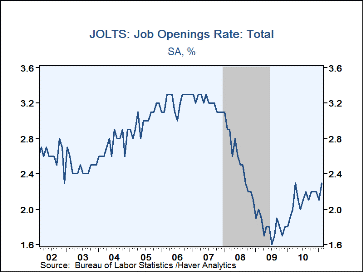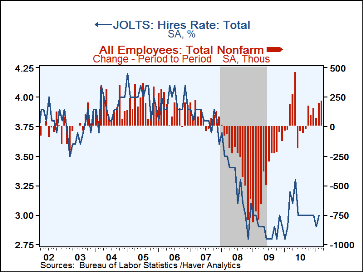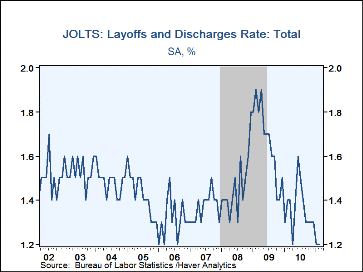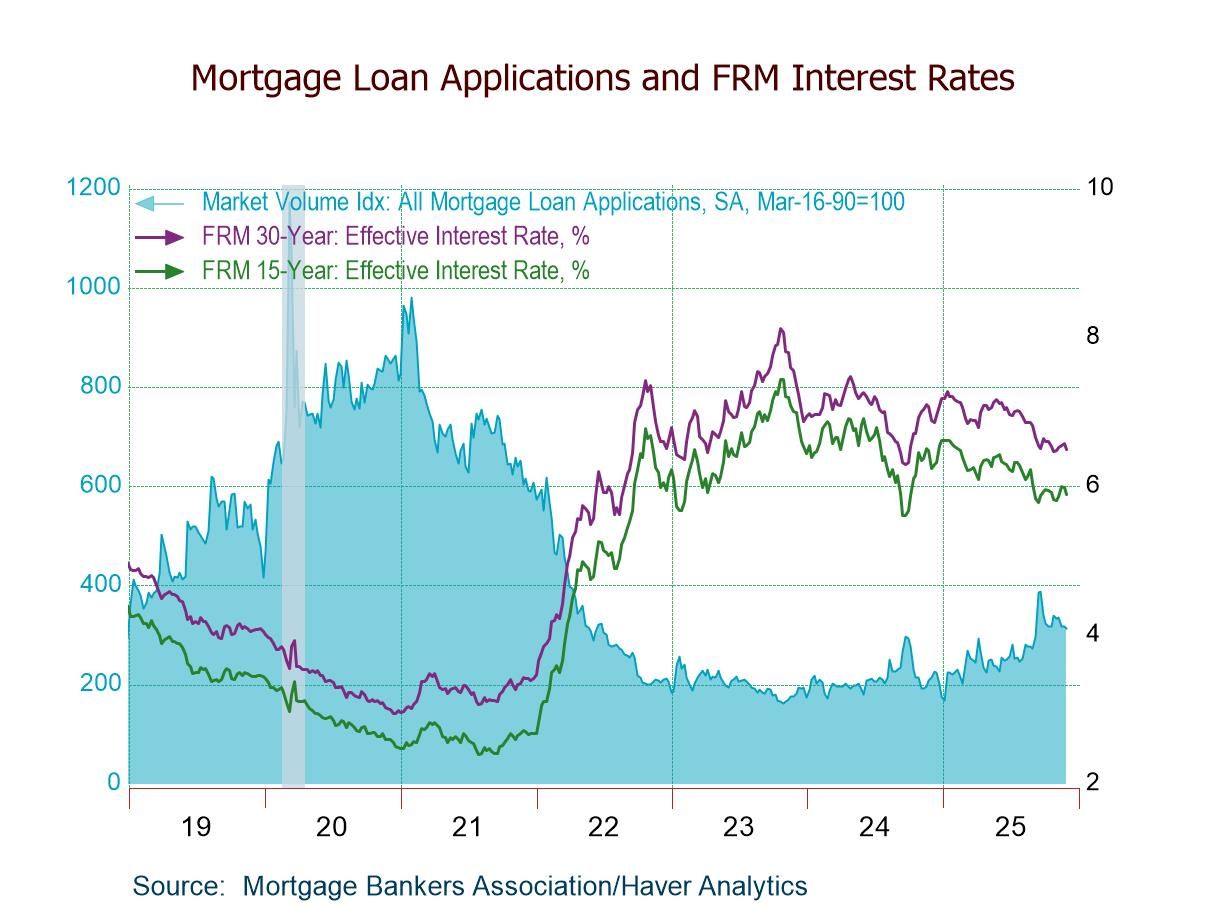 Global| Apr 13 2011
Global| Apr 13 2011U.S. JOLTS Rate Gains
by:Tom Moeller
|in:Economy in Brief
Summary
The Bureau of Labor Statistics reported in its Job Openings & Labor Turnover Survey (JOLTS) that the February job openings rate improved to 2.3% from an unrevised 2.1% during January. The latest reading was the highest since April [...]
 The Bureau of Labor Statistics reported in its Job Openings &
Labor Turnover Survey (JOLTS) that the February job openings rate
improved to 2.3% from an unrevised 2.1% during January. The
latest reading was the highest since April 2010 and was improved
versus the recession low of 1.6%. The job openings rate is the
number of job openings on the last business day of the month as a
percent of total employment plus job openings.
The Bureau of Labor Statistics reported in its Job Openings &
Labor Turnover Survey (JOLTS) that the February job openings rate
improved to 2.3% from an unrevised 2.1% during January. The
latest reading was the highest since April 2010 and was improved
versus the recession low of 1.6%. The job openings rate is the
number of job openings on the last business day of the month as a
percent of total employment plus job openings.
The private-sector job openings rate jumped to 2.5%, the highest level since August 2008. After a January drop, professional & business services job openings rebounded smartly to 3.8%, also the highest since 2008. Openings in leisure & hospitality, education & health and construction also improved. In manufacturing, openings slipped m/m but remained double the mid-2009 level. The job openings rate in government ticked up after the January plunge to nearly its 2009 low.
The hires rate recovered to 3.0% and it equaled the second-half, 2010 average. The hires rate is the number of hires during the month divided by employment. The 3.4% rate in the private sector also was stable with the second half of last year. The government's lower, but stable, 1.2% rate was up from the low but the actual number of hires was down 13.0% y/y. Hires in arts, entertainment & recreation were strongest with a 21.2% y/y rise followed by a 13.2% gain in professional & business services. During the last ten years there has been a 56% correlation between the total hires rate and the m/m change in payroll employment.
The job separations rate ticked up to 2.9% from close to its cycle low. The actual number of separations recovered most of its sharp 5.8% drop but also remained near the cycle low. Separations include quits, layoffs, discharges, and other separations as well as retirements. The layoff & discharge rate alone remained at its all-time low of 1.2%. The private sector layoff rate was 1.4% and in the public sector it was 0.5%.
The JOLTS survey dates only to December 2000 and the figures are available in Haver's USECON database.
| JOLTS (Job Openings & Labor Turnover Survey) | Feb | Jan | Dec | Feb'10 | 2010 | 2009 | 2008 |
|---|---|---|---|---|---|---|---|
| Job Openings, Total | |||||||
| Rate (%) | 2.3 | 2.1 | 2.2 | 1.9 | 2.2 | 1.8 | 2.1 |
| Total (000s) | 3,093 | 2,741 | 2,921 | 2,523 | 2,921 | 2,369 | 2,937 |
| Hires, Total | |||||||
| Rate (%) | 3.0 | 2.8 | 3.0 | 2.9 | 35.9 | 34.6 | 39.3 |
| Total (000s) | 3,907 | 3,769 | 3,905 | 3,784 | 46,557 | 45,207 | 53,901 |
| Layoffs & Discharges, Total | |||||||
| Rate (%) | 1.2 | 1.2 | 1.3 | 1.4 | 16.0 | 19.9 | 17.6 |
| Total (000s) | 1,591 | 1,541 | 1,677 | 1,755 | 20,614 | 26,191 | 23,705 |
Tom Moeller
AuthorMore in Author Profile »Prior to joining Haver Analytics in 2000, Mr. Moeller worked as the Economist at Chancellor Capital Management from 1985 to 1999. There, he developed comprehensive economic forecasts and interpreted economic data for equity and fixed income portfolio managers. Also at Chancellor, Mr. Moeller worked as an equity analyst and was responsible for researching and rating companies in the economically sensitive automobile and housing industries for investment in Chancellor’s equity portfolio. Prior to joining Chancellor, Mr. Moeller was an Economist at Citibank from 1979 to 1984. He also analyzed pricing behavior in the metals industry for the Council on Wage and Price Stability in Washington, D.C. In 1999, Mr. Moeller received the award for most accurate forecast from the Forecasters' Club of New York. From 1990 to 1992 he was President of the New York Association for Business Economists. Mr. Moeller earned an M.B.A. in Finance from Fordham University, where he graduated in 1987. He holds a Bachelor of Arts in Economics from George Washington University.








